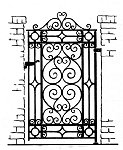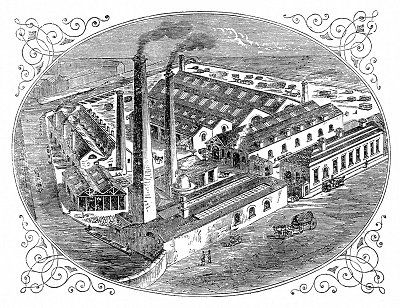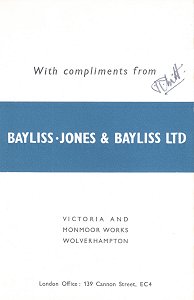|
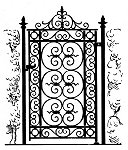 |
Bayliss Jones and Bayliss Ltd.Victoria Works, Cable Street |
|
The Company's Historyby Helen Priddey This history of the company was researched and written by Helen Priddey. The text first appeared in the Bugle for 13th March 2003. The illustrations and their captions have been added by the curator. The founder of the firm, William Bayliss, was born in 1803. William Bayliss's father was a blacksmith with a shop at the junction of Bilston Road and Ettingshall Lane. The shop served the nearby miners, sharpening their picks and shoeing their horses. The story is told of how terrified William used to be when he had to take the night turn stoking a pumping engine. The engine was located on dark, dismal ground that was a notorious hiding place for criminal and thieves escaping the Bow Street Runners. As he got older, William gradually took over his father's business. He was an efficient lad and when he started keeping records and introduced "pay on the nail", it excused his dad the Saturday journey around the public houses trying to get his mining customers to pay their bills. William saved hard and whilst still in his teens bought a large plot of wasteland in Cable Street, Wolverhampton. He established a firm there some years later in 1826. The Cable Street premises were named the Victoria Works and a small rolling mill foundry was installed. William married a young woman who was a regular member of the Wesleyan Chapel in John Street, Ettingshall, where he was class leader of the weekly prayer meetings. They moved into a house in George Street, Ettingshall and had two sons William and Samuel, who later joined the firm. Eventually his brother Moses (1816-1894), who had been a nut and bolt maker in Darlaston, joined him in the venture. The two firms were amalgamated as W. & M. Bayliss of Monmoor Green and Darlaston, and they had a London office at 43 Fish Street Hill, Eastcheap. In 1859 an iron trader from South Wales, Edwin Jones (1833-1904), who had married William's daughter, Jane, joined them and Bayliss, Jones and Bayliss Ltd was born. The company were very successful and Mr Jones became resident in London, running an office at 84 Cannon Street E.C. |
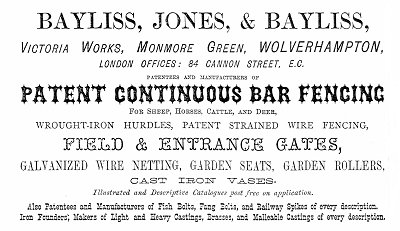 |
This advert from a trade directory of 1871 suggests that they were well established and making a great variety of objects, though apparently specialising in gates and fences. |
| It seems that Moses went to America to introduce the rolling of corrugated sheet iron, but this can't be verified. However, Moses was the father of Wolverhampton born Sir William Maddock Bayliss, who later became an eminent scientist and in 1902, at University College London, with E.H. Starling, discovered the hormone secretin and thus established the role of hormones. |
|
The illustration which accompanied the advert above shows the Victoria Works at Monmore Green. It probably exaggerates the size and tidiness of the buildings but would be generally accurate. Note the canal to the left, apparently still an important means of getting materials in and finished products out; but the open land to the top right suggests that road transport - at least as far as the railway - was also very important. |
|
|
In 1873 a Wolverhampton Trade Directory lists William, the founding member of the firm, as living in Oaks Crescent. He had moved here after he contracted a chest complaint, which was aggravated by the smoke and fumes in Monmore Green. At the time, Oaks Crescent was on the edge of a rural district. His journal expresses his pleasure at the blossoming trees, the clean air and the singing of the birds in the garden of his new home. A few years later, his doctors advised him to retire to the south coast and there he died. His son William lived at the time at The Firs, Merridale Road. He was known as a quiet and retiring sort who was at home in the office. Samuel, his brother, was more active and worked in the pattern shop of the foundry. The progress of the company continued unabated. |
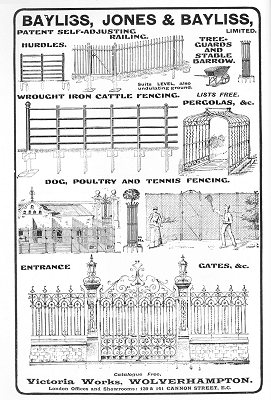 |
This advertisement from 1920 shows that they were making all sorts of fencing and gates, from the most utilitarian to the most elaborate. But they also made other things of a similar nature - palisade fencing could be bent round to form a tree guard and their wire netting and a few posts could become a tennis court. |
| This advert is from the later 1920s. |
|
| Around 1922 a man called Thomas Swift Peacock, representing the G.K.N. Group of Companies, negotiated the purchase of Bayliss, Jones and Bayliss. The G.K.N. company history reports the rumour that "William Bayliss, the then chairman and son of the founder, had diverted capital from the business into a country estate and had speculated unsuccessfully on the Birmingham Stock Exchange, drawing the company in to debt". It is generally understood that Mr Jones, who was still in control of the London offices, forced the issue by declaring his willingness to sell his portion of shares to G.K.N. Mr Jones' son Edwin, his son-in-law, Sir Murray Hyslop and finally his grandson Roy Hyslop, followed him in managing the London office and showrooms, which had expanded to 139-141 Cannon Street by 1938. |
|
|
This page heading from a 1928 catalogue shows - unusually - their trade mark. |
| This is a letter head from about 1938. The London Office is at 139 Cannon Street, London, E. C. 4. |
|
 |
This is from a leaflet of the same date. |
| And this compliments slip is also from the same date. It seems to be in a very advanced style. The remarkable thing is that the company managed three totally different styles on three of their bits of paper. The idea of a corporate image - the full Wilf Ollins - has not yet caught on. |
|
